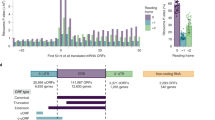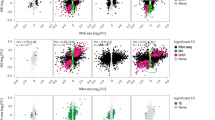Abstract
We have detected by immunoblotting analysis of crude fractions from suckling and adult rat brain, resolved by two-dimensional isoelectric focusing-dodecyl sulfate polyacrylamide gel electrophoresis, the presence of two different forms of the β subunit of polypeptide initiation factor 2 (eIF-2). These two forms differ in their apparent molecular weights and also in their isoelectric point values. Quantitation of both forms in the crude fractions shows that, the most basic form β1 (pI: 6.1, 52 kDa), is present in higher levels of the salt wash ribosomal fractions obtained from both, suckling and adult animals, than in the postmicrosomal fraction corresponding to the same animals. The most acidic form, β2 (pI: 5.9, 50 kDa), is present in the highest level in the postmicrosomal supernatant from adult animals. A close parallelism is found between β1 levels and eIF-2 activity.
Similar content being viewed by others
References
Pain, V. M. 1986. Initiation of protein synthesis in mammalian cells. Biochem. J. 235:625–637.
Rhoads, R. E. 1988. Cap recognition and the entry of mRNA in the protein synthesis initiation cycle. Trends. Biochem. Sci. 13:52–56.
Sarre, T. F. 1989. The phosphorylation of eukaryotic initiation factor 2: a principle of translational control in mammalian cells. BioSystems 22:311–325.
Ochoa, S. 1983. Regulation of protein synthesis initiation in eukaryotes. Arch. Biochem. Biophys. 223:325–349.
Duncan, R., and Hershey, W. B. 1983. Identification and quantitation of level of protein synthesis initiation factors in crude HeLa cell lysates by two-dimensional polyacrylamide gel electrophoresis. J. Biol. Chem., 258:7228–7235.
Duncan, R., and Hershey, W. B. 1985. Regulation of initiation factors during translational repression caused by serum depletion. Abundance, synthesis, and turnover rates. J. Biol. Chem. 260:5486–5492.
Duncan, R., and Hershey, W. B. 1985. Regulation of initiation factors during translational repression. Covalent modification. J. Biol. Chem. 260:5493–5497.
Clark, S. J., Colthurst, D. R., and Proud, C. G. 1988. Structure and phosphorylation of eukaryotic initiation factor 2. Casein kinase and protein kinase C phosphorylate distinct but adjacent sites in the β subunit. Biochim. Biophys. Acta. 968:211–219.
Alcazar, A., Mendez, E., Fando, J. L., and Salinas, M. 1988. Specific phosphorylation of the β subunit of eIF-2 factor from brain by three different protein kinases. Biochem. Biophys. Res. Commun. 153:313–320.
Jagus, R., Crouch, D., Konieczny, A., and Safer, B. 1982. The role of phosphorylation in the regulation of eukaryotic initiation factor 2 activity. Curr. Top. Cell. Regul. 21:35–63.
Kimball, S. R., Everson, W. V., Myers L. M., and Jefferson, L. S. 1987. Purification and characterization of eukaryotic initiation factor 2 and a guanine nucleotide exchange factor from rat liver. J. Biol. Chem. 262:2220–2227.
Dholakia, J. N., and Wahba, A. J. 1987. The isolation and characterization from rabbit reticulocytes of two forms of eukaryotic initiation factor 2 having different β-polypeptides. J. Biol. Chem. 262:10164–10170.
Price, N. T., Nakielny, S. F., Clark, S. J., and Proud, C. G. 1989. The two forms of the β-subunit of initiation factor-2 from reticulocyte lysates arise from proteolytic degradation. Biochem. Biophys. Acta. 1008:177–182.
Fando, J. L., Dominguez, F., and Herrera, E. 1981. Tryptophan overload in the pregnant rat: effect on brain amino acid levels and in vitro protein synthesis. J. Neurochem. 37:824–829.
Dunlop, D. S., Elden, W. V., and Lajtha, A. 1977. Developmental effects on protein synthesis rates in regions of the CNS in vivo and in vitro. J. Neurochem. 29:939–945.
Calés, C., Salinas, M., Alcázar, A., and Fando, J. L. 1988. Differential subcellular distribution of guanine nucleotide exchange factor in suckling and adult rat brain. Neurosc. Letters 87:271–276.
Martín, E., Alcázar, A., and Salinas, M. 1990. Subcellular and regional distribution of casein kinase II and initiation factor 2 activities during rat brain development. Int. J. Devl. Neurosc. 8:47–54.
Calés, C., Salinas, M., and Fando, J. L. 1985. Isolation of eukaryotic initiation factor 2 from rat brain. J. Neurochem. 45:1298–1302.
Bradford, M. (1976). A rapid and sensitive method for the quantification of microgram quantities of protein utilizing the principle of protein-dye binding. Anal. Biochem. 72:248–254.
Vaitukaitis, J. L. 1981. Production of antisera with small doses of immunogen: multiple intradermal injections. Methods in Enzymology 73:46–52.
Hawkes, R., Niday, E., and Gordon, J. 1982. The dot-immunobinding assay. Anal. Biochem. 119:484–491.
Laemmli, U. K. 1970. Clearage of structural proteins during assembly of the head of bacteriophage T4 Nature 227:680–685.
O'Farrell, P. H. 1975. High resolution two-dimensional electrophoresis. J. Biol. Chem. 250:4007–4021.
Johnson, T. C. 1976. Regulation of protein synthesis during post-natal maturation of the brain. J. Neurochem. 27:17–23.
Dunlop, D. S., Bodony, R., and Lajtha, A. 1984. RNA concentration and protein synthesis in rat brain during neural development. Brain Res. 294:148–151.
Calés, C., Fando, J. L., Azuara, C., and Salinas, M. 1986. Developmental studies of the first step of the initiation of protein synthesis, role for initiation factor 2. Mech. Ageing Devl. 33:147–156.
Vargas, R., and Castañeda, M. 1983. Age-dependent decrease in the activity of protein synthesis initiation factors in rat brain. Mech. Ageing Devl. 21:183–191.
Kimball, S. R., Rannels, S. L., Elensky, M. B., and Jefferson, L. S. 1988. Quantitation of proteins by dot-immunobinding assay. A comparison of visualization methods using eukaryotic initiation factor 2 and a monospecific antibody. J. Immunol. Methods 106:217–223.
Maurides, P. A., Akkaraju, G. R., and Jagus, R. 1989. Evaluation of protein phosphorylation state by a combination of vertical slab gel isoelectric focusing and immunoblotting. Anal. Biochem. 183:144–151.
Pathak, V. K., Nielsen, P. J., Trachsel, H., and Hershey J. W. B. 1988. Structure of β subunit of translational initiation factor eIF-2. Cell 54:633–639.
Author information
Authors and Affiliations
Additional information
Special issue dedicated to Dr. Santiago Grisolia.
Rights and permissions
About this article
Cite this article
Martín, M.E., Montero, T., Alcázar, A. et al. Heterogeneity in the β-subunit of translational initiation factor eIF-2 during brain development. Neurochem Res 16, 749–755 (1991). https://doi.org/10.1007/BF00965683
Accepted:
Issue Date:
DOI: https://doi.org/10.1007/BF00965683




